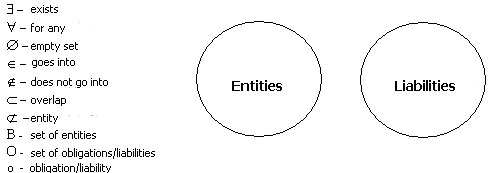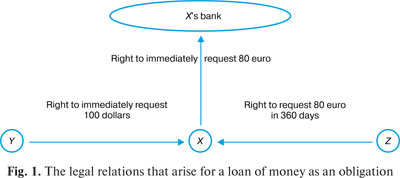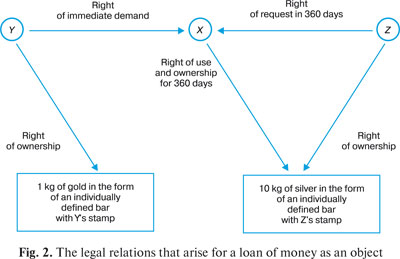Legal differences in the treatment of objects and liabilities
"An object has its own distinguishing signs, the most important
of which is the externally expressed material form of
an object."
D. V. Murzin 21
There is a clear difference between property laws and liability laws.
The application of either standard is mutually exclusive.
When jus ad rem grants its bearer the opportunity to directly exert
influence upon it (when the object of the law is the article), the law is
called proprietary. In Rome, property law was closely related to proprietary
interest, and ownership and other laws on other people’s articles
are closely linked to them. In cases where the subject has no direct right
to an article, but has only the right to demand that another party gives
him an article, this law is called contractual. Thus, differences between
proprietary and contractual laws develop according to the object of the
law: if the object of a law is an article, then we are dealing with proprietary
law; if the object of a law serves the action (or abstention from
action) of another party, but the subject of the law may only demand that
an agreed action be completed (or abstention from the action), then this
is contractual law. In other words, various civil legal relations correspond
to defined groups of objects of civil rights. From this perspective,
differentiation between property and contractual laws holds great significance,
as it predetermines the differences in legal conditions for
concrete objects.
Unfortunately, nowadays attempts to merge the different legal procedures
are not uncommon. Instead of onerous concessions of rights,
attempts are made to «buy and sell» «uncertificated securities», and to
consider shareholders as «holders of rights» to shares and «to rent interest
in land» 22.
The classification of property rights into proprietary and contractual
is not referred to among Roman lawyers, who spoke only of the
differences of property suits (actiones in rem) and personal actions
(actiones in personam). The differentiation between proprietary and
contractual laws was worked out later by legal experts, though based on
the materials that Roman lawyers had had. Nevertheless, the latter paid
attention to the fact that the legal position of a party holding proprietary
rights to an article and the legal position of a party entering into an agreement
with the owner of an article to the effect that the latter is obliged
to give him the article for temporary use are not the same. In the first
case, the owner has the opportunity to directly exert influence on the
article — to use it, destroy it, transfer it to another party, and so on
(‘directly’ in the sense of independently from any other party). In the second case, the debtor’s rights to the article are limited, firstly by the
period of use which he has agreed with the owner (or the time when the
latter demands the article, if a concrete period of time has not been
stipulated), and, secondly, the need to return the article (that is, he may
not destroy or sell it).
The principal difference between the transfer of property rights (the
establishment of easement) and a party’s acceptance of the obligation
to transfer ownership of an article (carry out another action) lies in the
fact that the obligation of one party to grant another ownership of a
known article does not immediately create property rights to this article
for the other party. Only as a result of fulfilling such an obligation and
under other necessary conditions does the party who has acquired the
article become its owner. Only the right to demand transfer of the article
springs directly from the obligation. Therefore, the party who bought
the article still does not become its owner even on condition of payment
of the purchase price. This party only has the right to demand transfer
of the article to him, and only becomes the owner after the article has
actually been transferred and on the condition that the person who
transferred the article had property rights to it.
Thus the difference between proprietary and contractual laws that is
accepted in modern civil law, is also found (conditionally) among the
Roman lawyers. As a result of this difference in the object of law the difference
in defence arises, which Roman lawyers expressed as a contrast
between property and personal actions. Modern law has come up with two
categories to express this idea: absolute and relative (Table 1).
This idea is based on the following principle: legal relations for
ownership of material goods by specific parties have an absolute nature
— the authorised holder of right is in opposition, so to speak, to
an undefined group of individuals (by all other parties) who are obliged
to refrain from any infringements of the law against his property and
not to hinder the realisation of his rights. The Roman legal experts also
considered that, since the object of proprietary interest is a physical
item and anyone can encroach upon it, proprietary interest must be
defended against every infringer of the law, whoever it may be; proprietary
interest is used as an absolute defence against a personal action.
In contractual law, a party may request an individual or several precisely
defined individuals to execute a particular action. Therefore, infringers of contractual law are either one party or several specific
parties, against whom the subject of the law may bring a personal action.
Here, protection of contractual law is of a relative nature.
Having rented out a material object, the owner does not lose his
property rights to it. When intangible and immaterial receivables are
transferred, the creditor simply «quits», his relationship to this right
ceases, he completely withdraws from the legal relations.
Both in Roman and modern civil law, from the very beginning, a contractual
legal relationship was seen at its natural end as a means of fulfilling
a certain action within the fixed deadline. It differs in this way from
property rights, established for an indefinite, extended period of time. In
cases where a debtor deliberately does not fulfil his duties, the creditor
is granted legitimate means, that is, established by law, of compulsorily
realising his right of demand. Such a method of forcing the debtor
to satisfy the demands of the creditor under a commitment in Rome
was a personal action or forced penalty. Ancient Roman lawyers also
defined a debtor as a party who whose debt could be recovered against
his will.
Legal standards are a particular kind of judgement. Their content
reflects the wishes of a legislator in that duty of fulfilment about which
there is no doubt. In this sense, legal standards are true judgements.
But a judgement with internal necessity turns into a deduction which
is used to justify the judgement. «The transition of a judgement into a
deduction, which is a justification of its grounds, is a synthetic link,
a definite system of seniority, which is also a logical development»23
| Criterion |
Proprietary interest |
Law of obligation |
| Object |
Article |
Right to demand execution
of an action (or abstention
from it) |
| Influence of the
right-possessing
party |
Direct |
Request for influence |
| Nature of legal
relations |
Absolute — with regard to
everything |
Relative — with regard to a
strictly defined party or
group of individuals |
| Number of rights
with regard to object
of law |
Trio of competences:
Instruction
Ownership
Use
|
Single competence: Request for defined action to
be executed |
| Status of object of
law |
Complex:
Belongs to X
In possession of Y
Used by Z
|
Simple: Exists or does not exist (logically — 1 or 0) |
| Period of legal
relations |
Indefinite (perpetual) |
Definite (as a rule) |
|
Situations that arise in the course of the logical development of normative
judgements must obviously also not provoke doubt with regard to
wishes concluded in them. The will and intention of a legislator, developed
as a chain reaction — «judgement-deduction-judgement» — are
as reliable as their primary element — the standard of law, although we
must still always proceed from the fact that in publishing a normative
act, a legislator has thought through all its logical and factual consequences
and conclusions at which a body that applies the law may arrive.
Drawing from the definitions:
an entity is an object belonging to the material world;
an obligation is the right to request a certain person to carry out
certain actions or to refuse to do so.
The right to request is immaterial; an entity, material.
Speaking in terms of logic, many entity-objects and liability-objects
do not overlap, or the application of property or contractual legal standards
are mutually exclusive.

We shall note:

Correspondingly, the rules of circulation for entities must also be
applied to liabilities. Is it really possible to have a right of ownership to
a right of demand? Is it really possible to give to whomever the right to
temporarily use a right of demand? E. A. Sukhanov believes that «objects
of property rights are a narrow concept, encompassing only goods,
i.e. items belonging to the material world.»24.
Either there is a right of demand, or there is not. It can be transferred,
but for several people to use such a right at the same time is not
possible, since it draws twice as many rights and corresponding obligations
without agreement with the creditor upon a commitment.
Dualism of proprietary law and contractual law is caused by the
absolute non-identity of an article and a person.
There are principal differences in the treatment of objects and liabilities.
Property rights, ownership, holding property, and instruction to right
of demand cannot exist, as the right is not a material object.
Personal actions are not applied to obligations, and suits forcing
fulfilment are not applied to goods, as goods cannot be compelled to do
anything — they are not spiritual beings.
In institutionalism and neo-institutionalism, the position conveyed
by Coase prevails, that on the market, material goods themselves do
not circulate, but rather bundles of rights to them, and it is precisely
these bundles of rights that reveal the real relations between economic
subjects in regards to material goods.
Let’s consider some examples of the formation of bundles of rights
with a monetary loan as an obligation and as an article.
An example of the formation of a bundle of rights with a monetary loan
as an obligation.
Let us assume that a certain X borrowed 100 US dollars from Y in
non-cash form for a term of five days and lost them on the second day.
On the third day X borrowed 80 euro from Z in non-cash form for a term
of one year (taking an exchange rate of 1 dollar to 0.8 euro). On the sixth
day there are the following legal relations — bundle of rights (Fig. 1):
- contractual — X is obliged to pay Y 100 US dollars in non-cash
form immediately;
- contractual — X is obliged to pay Z 80 euro in non-cash form in
360 days’ time;
- contractual — the bank is obliged to pay X 80 euro in non-cash
form on demand.
Protecting his rights, Y has the right to demand satisfaction from X’s
assets, which is expressed in the form of the right of immediate demand
to the bank for 80 euro, which the officer of the court on the decision
of the court withdraws by coercion from X bank and transfers to Y
bank.

Example of the formation of money as an object.
Let us assume that a certain X has borrowed from Y 1 kg of gold in
the form of an individually defined bar with Y’s stamp for a term of five
days and lost it on the second day. On the third day, X borrowed from Z
10 kg of silver in the form of an individually defined bar with Z’s stamp
for a period of one year (taking an exchange rate of 1 kg gold = 10 kg
silver). On the sixth day, when the deadline for payment by X has come,
there are the following legal relations — bundle of rights (Fig. 2):
- proprietary — Y has the right of ownership to 1 kg of gold in the
form of an individually defined bar with Y’s stamp;
- contractual — X is obliged to give Y 1 kg of gold in the form of
an individually defined bar with Y’s stamp immediately, as the period
of temporary ownership and use has elapsed;
- proprietary — Z has the right of ownership to 10 kg of silver in
the form of an individually defined bar with Z’s stamp;
- proprietary — X has the right to own and use 10 kg of silver in the
form of an individually defined bar with Z’s stamp for 360 days;
- contractual — X is obliged to give Z 10 kg of silver in the form of
an individually defined bar with Z’s stamp in 360 days’ time.
Protecting his rights, Y does not have the right to demand satisfaction
from X’s assets, which are expressed in the form of 10 kg of silver
in the form of an individually defined bar with Z’s stamp, since the right
of ownership to these 10 kg of silver belongs only to Z, and nobody
except the owner has the right to remove this article from X25 .

These examples demonstrate the formation of different bundles of
rights and the difference in handling money in proprietary and contractual
form, thus showing that different forms of treatment exist for
different forms of money.
|





